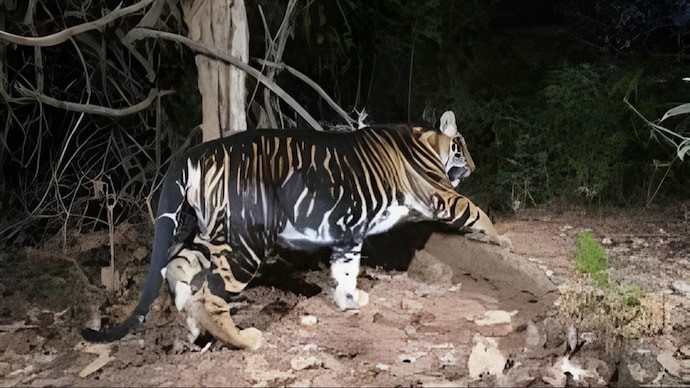Description

Disclaimer: Copyright infringement not intended.
Context
- The government told the Rajya Sabha that there are 10 black tigers (melanistic tigers) in India and all are found exclusively in Odisha's Similipal tiger reserve.
Black Tigers
About
- Black tigers, also known as melanistic tigers, are a rare color variant of the Panthera tigris species, characterized by a distinct black coat with dark stripes.
- This genetic variation is a result of the presence of a specific gene responsible for pigmentation.
Genetic Basis:
- The black coloration is attributed to the presence of the melanistic gene, which influences the production of pigments, particularly melanin.
- A single mutation in the gene Transmembrane Aminopeptidase Q (Taqpep) results in black colour.
- This gene is inherited from the parents, and the cub must inherit the gene from both parents to express the melanistic trait.
Geographical Distribution:
- Melanistic tigers have been reported sporadically across various regions, but they are particularly associated with the dense forests of the Indian subcontinent.
- Some melanistic tigers have been observed in the forests of the Indian states of Odisha, Assam, and the Sundarbans mangrove region.
Frequency and Rarity:
- Melanistic tigers are extremely rare, constituting only a small percentage of the overall tiger population.
- Their rarity is due to the need for both parents to carry the melanistic gene for a cub to express this coloration.
Threats:
- Like other tiger subspecies, melanistic tigers face threats such as habitat loss, poaching, and human-wildlife conflict.
IUCN status

Similipal Tiger Reserve
Location:
- Mayurbhanj district, Odisha; part of the Similipal-Kuldiha-Hadgarh Elephant Reserve.
Tribes:
- Home to Erenga Kharias and Mankirdias tribes.
Geography:
- Diverse landscapes with major rivers Khairi and Deo.
Conservation:
- Distinct genetic cluster prioritized for conservation.
Melanistic Tigers:
- Sole population of melanistic tigers globally.
Recognitions:
- Tiger reserve since 1956; under Project Tiger since 1973.
- Declared a biosphere reserve in 1994.
- UNESCO World Network of Biosphere Reserve since 2009.
Other Protected Areas in Odisha:
- Part of a network including Bhitarkanika National Park, Chilika (Nalaban island) WLS, Baisipalli WLS, Nandankanan WLS, and Gahirmatha (Marine) WLS.
- Similipal Tiger Reserve, with its unique melanistic tigers and diverse ecosystems, epitomizes India's commitment to biodiversity conservation on both national and global fronts.
|
PRACTICE QUESTION
Q. Which Indian state is home to the exclusive population of melanistic tigers, also known as black tigers.
1.Assam
2.Odisha
3.Maharashtra
4.West Bengal
Answer: 2. Odisha
|












